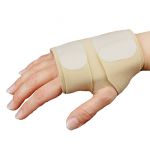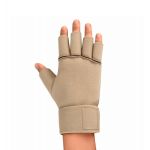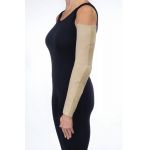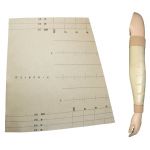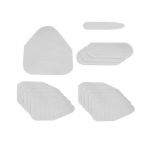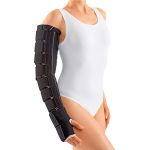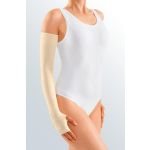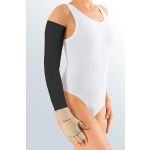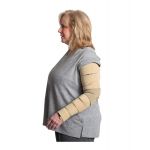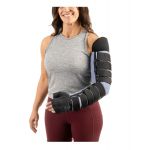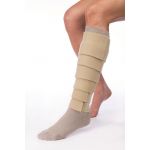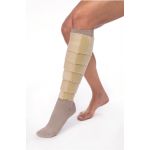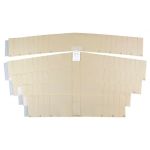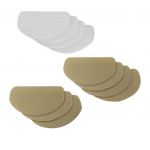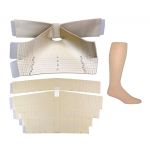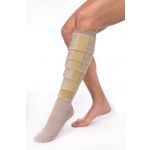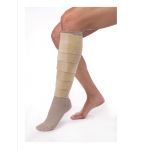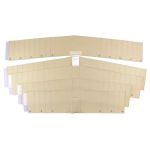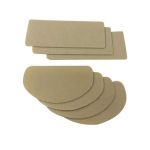Compression Garments
Lymphedema compression garments, compression sleeves, and more
At Bandages Plus we have a huge selection of lymphedema compression garments, for the prevention of lymphedema, as well as the treatment of mild, moderate, severe, or hard-to-control lymphedema.
Shop our compression garments with pre-tax savings using your FSA or HSA account!
Lymphedema Compression Garments, Compression Sleeves, And More
Our selection of lymphedema compression garments includes:
- lymphedema compression wraps for arms
- lymphedema compression wraps for legs
- lymphedema compression stockings
- arm compression sleeves for lymphedema
- leg compression sleeves for lymphedema
- compression bras for lymphedema
- compression socks for lymphedema
- leggings for lymphedema (including plus-size leggings)
- compression boots for lymphedema
- compression gloves for lymphedema
- compression gauntlets for lymphedema
As you’re shopping for the appropriate lymphedema garments for your condition, please note that there are varying levels of compression garments. In order to choose the correct compression level, please follow the compression guidelines below.
- Class 0: 15-20 mmHg (for people who are at risk of lymphedema)
- Class I: 20-30 mmHg (for people who are at risk or have early lymphedema or mild lymphedema)
- Class II: 30-40 mmHg (for people who have moderate lymphedema or severe lymphedema)
- Class III: 40-50 mmHg (for people who have severe lymphedema or hard-to-control lymphedema)
*Note that mmHg is a measurement of compression and refers to “millimeters of mercury”.
••••••••••••••••••••••••••••••••••••FAQs About Compression Garments
Lymphedema compression garments play an important role in managing lymphedema, edema, venous insufficiencies, and other medical conditions. Below are some of the most frequently asked questions about compression garments.
- How Do Compression Garments Work For Lymphedema
- Can Compression Garments Prevent Lymphedema
- What Types Of Compression Garments Are Available For Lymphedema
- What Are The Most Common Levels Of Compression In Garments
- 15-20 mmHg (mild compression)
- 20-30 mmHg (moderate compression)
- 30-40 mmHg (firm compression)
- 40-50 mmHg (extra firm compression)
- What Does mmHg Mean In Compression Garments
- How Do I Chose The Right Size And Type Of Compression Garment
- Can I Wear My Compression Garment When I Exercise
- How Tight Should My Compression Garment Be
- How Long Should I Wear My Compression Garment Each Day
- Can I Wear My Compression Garment While I Sleep
- How Do I Care For And Clean My Compression Garment
- How Often Should I Replace My Compression Garment
- Do I Need A Prescription To Get A Compression Garment
- Do Insurance Companies Cover Compression Garments
- Does Medicare Cover Compression Garments
Compression garments help manage lymphedema by applying pressure to the affected area, which helps promote lymph flow and reduce swelling. Lymphedema compression garments provide graduated compression, tighter at the end farthest from the heart, gradually lessening toward the end closest to the heart. This helps push lymph fluid toward the heart.
There is no cure for lymphedema, but compression garments can help manage and control the symptoms.
We have a large selection of compression garments for lymphedema, including: wraps, sleeves, stockings, pantyhose, gloves, gauntlets, shorts, leggings, bras, vests, and more.
Lymphedema compression garments are categorized by the amount of pressure they apply to the body, measured in millimeters of mercury (mmHg). In different garments, the levels of compression can vary, but the most common ones are:
Millimeters of mercury (mmHg) is a unit of measurement for pressure. In the context of compression garments, mmHg refers to the amount of pressure (tightness) that the garment applies to the body. Higher mmHg numbers represent more pressure.
For all of our lymphedema compression garments, we have sizing charts from the manufacturer. For most garments, you will take multiple measurements to ensure the correct fit. Your healthcare provider will recommend the compression level.
Your healthcare provider should make specific recommendations. In general, however if you are wearing the appropriate compression garment, exercising can help enhance lymphatic drainage and circulation.
Your compression garment should be snug, but not painfully tight. The garment should apply steady pressure, without restricting or cutting off your circulation.
Your healthcare provider should make specific recommendations. In general, however, lymphedema compression garments are worn during waking hours.
Your healthcare provider should make specific recommendations. In general, however, wearing compression garments while you are sleeping is not generally recommended unless they are specifically designed for nighttime wear.
Each manufacturer of compression garments has specific care and cleaning instructions, but many of the garments can be machine washed in a mild detergent (and air dried).
Over time, most lymphedema compression garments lose elasticity (and therefore effectiveness), and they should be replaced every 3-6 months.
No. You can order all of our compression garment products without a prescription. However, we do recommend that you consult a healthcare professional to ensure that you get the recommended garment, if you are unsure as to what you need.
Some insurance plans cover compression garments, with a prescription. Check with your insurance provider for specifics about your coverage.
Starting in January 2024, thanks to the Lymphedema Treatment Act, Medicare began covering compression garments for lymphedema. The Medicare Part B coverage is limited to: 3 daytime compression garments per affected body part (every 6 months) and 2 nighttime compression garments per affected body part (every 6 months). Click here to read more about the Lymphedema Treatment Act and how to order compression garments.
Please note that all of the information above is for general informational purposes. Please consult your healthcare provider for specific information and personalized recommendations for your situation.
For more information about our compression garments for lymphedema, please call (800) 700-1032, or e-mail info@bandagesplus.com
••••••••••••••••••••••••••••••••••••Medicare Pays For Lymphedema Products
Please note: Thanks to the Lymphedema Treatment Act, which took effect on January 1, 2024, Medicare began to pay for lymphedema products for those who have Medicare B coverage and meet certain other coverage criteria. Please visit our website page covering the details of the Lymphedema Treatment Act to obtain more information about how Medicare pays for lymphedema garments, wraps, and bandages.


